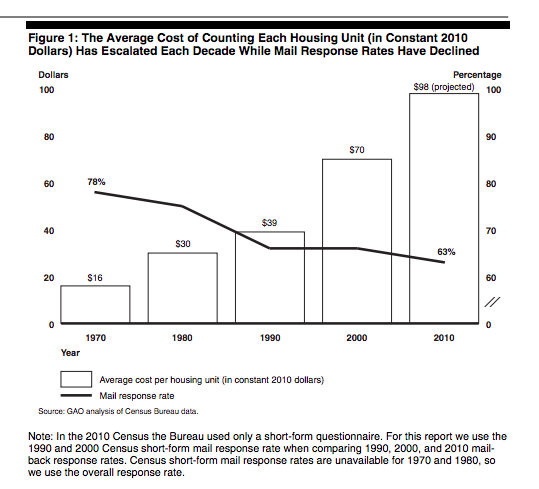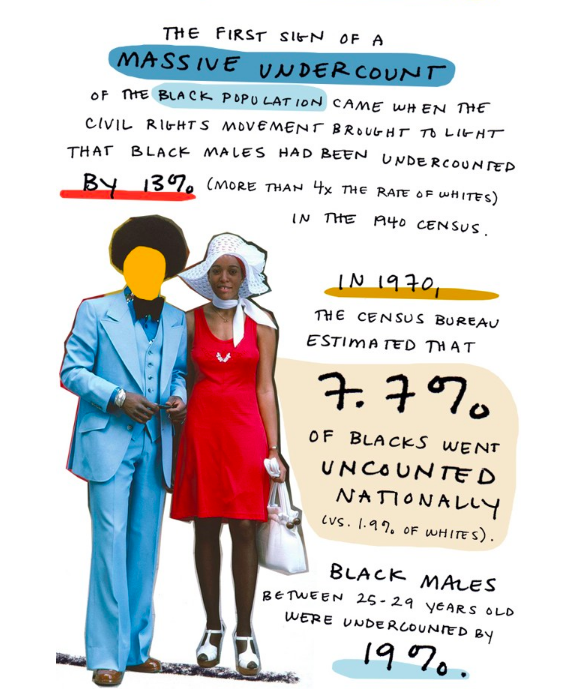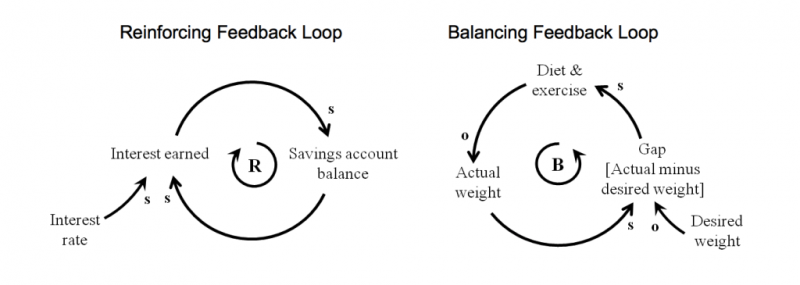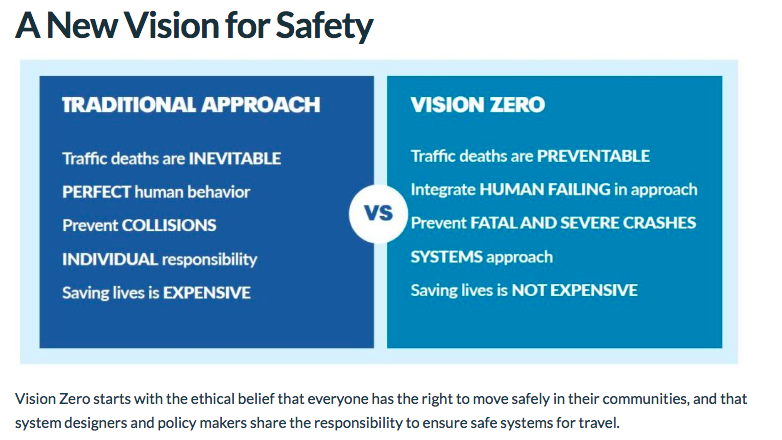Calling For A Census Systems Makeover
Posted on November 14, 2019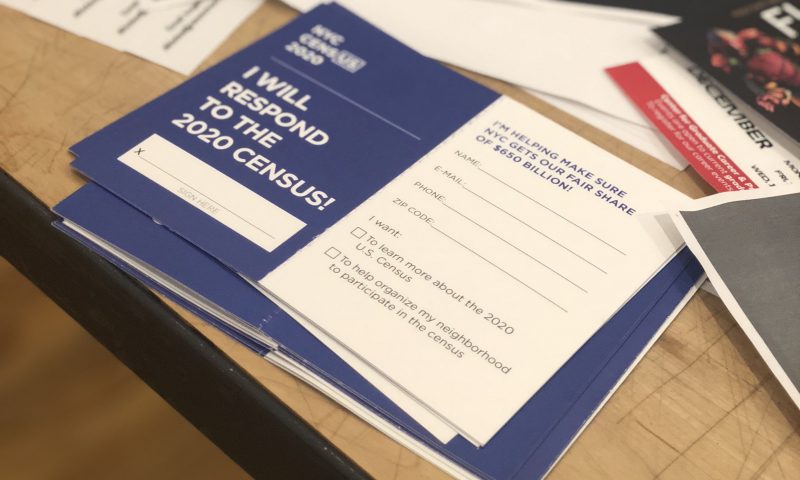
Census pledge card at The New School. Credit: M. Young
The 2010 Census has an outsized impact on my love life. It forced a question my boyfriend Ben and I were otherwise avoiding. Were we living together or not?
Ben told me not to put me on his form because he was going to have his mom put him on hers. But Ben wasn’t staying at his mom’s. A great alibi for non-committal 25-year olds like him, this kind of falsified data may be what led to a 2016 Pew report stating millennials were more likely to live with their parents than romantic partners. [1] He had, in fact, been staying at my studio on April 1, which is how the Census Bureau wants you to count who is in your household. In the end, I lied to the government – a crime that could have cost me a $500 fine. I scrawled the number one on the census form and shoved it into the mailbox.
Census Season, Here We Come
Non-committal partners beware – census season is around the corner. Starting in March 2020, households across the country will receive mailings inviting them to take the census online, by phone or, in areas where there is low internet access, with a paper form. [2] As was the case with me and my now, yes, husband Ben, the census often sparks controversy, confusion and power plays within systems.
Why does the census even exist? The constitution mandates that, every ten years, the government counts “all persons” living in the country. This count is then used to determine how many seats in Congress each state gets and informs how billions of dollars of federal funding are allocated to states and communities each year. [2] For example, knowing the number of children in a neighborhood helps government determine the number of schools needed. Knowing the number of people in a given area helps determine the need for new construction of libraries, roads, locations of police and fire departments and more. Community organizations use the data to determine where their services may be needed and businesses use it to decide where to open factories, movie theaters, banks and more. Even 911 emergency systems are based on maps created with census data. [3] The census is also a civil rights issue since accurate, comprehensive race and ethnicity data “plays a key role in the implementation and enforcement of the nation’s civil rights laws.” [4] How accurate a census count is each decade has huge ramifications for communities.
However, it is no easy task to count every person living in the country. The cost of the census nearly doubles every 10 years while response rates go down. [5] Certain populations tend to be undercounted more than others – people of color, immigrants, children under five, renters, rural residents, low income households or single parent households, just to name a few. [6] For example, “approximately 80% of Kings County’s current population (or 2,111,299 people) lives in hard-to-count neighborhoods in Brooklyn.” [7] These census tracts are some of the “hardest to count” in the country.
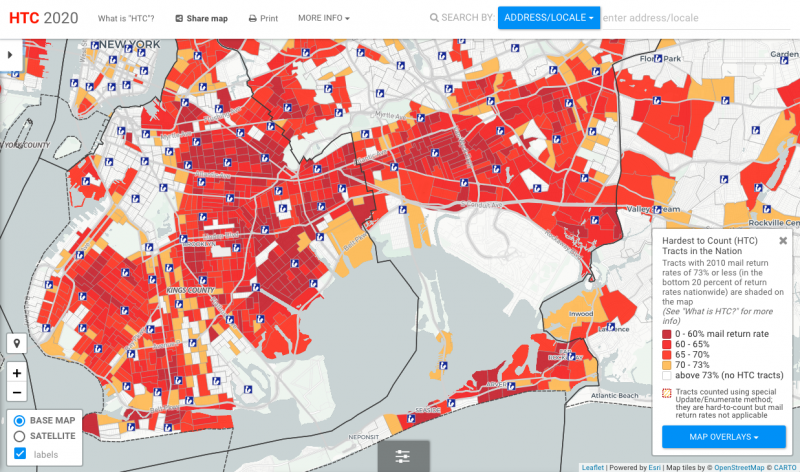
Data visualization showing Kings County in Brooklyn is one of the “hardest-to-count” areas of the country. [7]
For the first time ever, in 2020, the Census Bureau will be urging most households to take the census online. [7] While this helps them cut costs, it may actually worsen undercounts of populations without internet access. For example, 21.6% of Kings County does not have internet at home or has dial up only. [7] In fact, the Urban Institute estimates the 2020 Census could lead to the worst undercount of black and Latinx people in 30 years. [8] This is not only due to the digital divide, but also the rampant manipulations from self-serving politicians intimidating vulnerable communities with threats of citizenship questions, confusing people with fake censuses disguised as Republican fundraising appeals or passively sabotaging the count by withholding needed funding. (We’re looking at you, Governor Cuomo.) One community organizer I interviewed in South Texas said plainly, “We know they don’t want us to be counted.” And, finally, let’s not forget how the census, for pretty much all of its history, has been used as a tool of white supremacy. [9] Check out this visual history of the census for more on that. [10]
From A Reinforcing To A Balancing Feedback Loop
Donella Meadows’ book, “Thinking In Systems,” outlines methods for mapping out and understanding complex systems. [11] She discusses various kinds of feedback loops – including balancing feedback loops that help regulate a system or reinforcing loops that lead to snowballing or exponential behavior within systems.
The census can be thought of as a system itself, but we can also think of it as a feedback loop within the larger system of U.S. government. Unlike voting, it is a radically inclusive civic action where all individuals – regardless of their immigration status or age – have a voice in the process to secure greater representation and resources for their community. While the census has all the ingredients to be a powerful mechanism to correct inequities across the population, it has historically been co-opted by the powers that be as a tool to consolidate control. In systems thinking speak, the census is currently a reinforcing feedback loop – helping those in power stay in power. However, it could be transformed into the balancing feedback loop it was always meant to be. In this way, it would actually do its job redistributing political power and resources according to shifting population demographics.
The Census As A Trimtab Of U.S. Government

The trimtab of a ship, in yellow. Source: Steve Strauss [13]
Another metaphor to think of is the census as the tiny trimtab of the hulking, sometimes sinking ship of U.S. government. How do captains actually change the direction of a ship speeding full force ahead? The steering wheel turns the rudder, which turns the ship? Not quite. Because there’s so much water pressure on the rudder, the wheel actually turns a smaller flap on the end of the rudder – the trimtab. The trimtab then turns the rudder, which turns the ship. [13] This is a classic metaphor used to describe how a small change in the right place can lead to bigger changes or how identifying the right leverage point in a system can have cascading effects that shift its entire trajectory.
Because the census is what determines the allocation of congressional seats to each state and therefore shifts the borders of congressional districts as well, it is a very significant leverage point in our political process with the potential to shift its trajectory and equalize power imbalances. This is where those self-serving politicians come in. If you’re a politician currently in power, why would you want to support a process that might shift power away from you? For example, if your state’s population has shifted such that your political party might lose power, would you feel tempted to, I don’t know, intentionally neglect census outreach so that populations that don’t support you are undercounted?
A State Intentionally Aims To Undercount Its Population
Let’s take the case of Texas. According to the Urban Institute Report, Texas is considered one of the states with the highest risk of undercounting, along with California, Georgia, New York, Nevada and New Mexico. [14] Texas stands to gain 3-4 congressional seats with an accurate count or stands to lose millions of federal dollars with an undercount. The Center for Public Policy Priorities estimates a “mere 1% undercount could cost Texas $300 million in federal funding a year.” [15] However, unlike these states, Texas has chosen not to allocate any state funding or provide any statewide coordination to ensure an accurate count. Nothing. No money. $0. No coordination.
By comparison, California has allocated $187 million and New York, in theory, has allocated $20 million though the funds have yet to be released. (Governor Cuomo, I’m sure you’re reading this – please release those funds thanks.) So what’s that all about? This is one of many cases of self-serving politicians undermining the census’ roll out, intentionally discounting the very communities they claim to serve in order to protect their own positions. Texas state leaders would rather risk millions of dollars that its population deserves as a way to preserve power.
In September, I spoke with Martha Sanchez, a community organizer that works for LUPE, an organization advocating for migrants in the Rio Grande Valley. Located in South Texas along the border with Mexico, this rural area is considered one of the fastest growing in the U.S. and was severely undercounted in the 2010 Census. Given the lack of state-level census coordination and the fear-mongering around the citizenship question, organizers knew they had to step up to get out the count. They have been working for the last year, pounding the pavement with local city and county governments to try to prevent an undercount. With little internet access in the region, the census going online does not help things.
Now, I hope that these organizers succeed and get a complete count in 2020 so their communities get the federal representation and funding they deserve. But if they are undercounted yet again in 2020, what will we say about it? That this region was just too “hard-to-count?” As mentioned, Texas could gain congressional seats with an accurate count, but given the shifting demographics of the state, this might turn Texas from red to blue. This is something, I suspect, its Republican leaders would rather not happen. South Texas is not “hard-to-count;” it is being discounted by its own state leaders.
Census Undercounts Are A Systems Outcome
Because the current census system is so vulnerable to political manipulations, it is biased to undercount or, as I would argue, discount certain communities. “Hard-to-count” is a common term used by the Census Bureau to describe communities with low census self-response rates. I personally hate it. It centers he-who-is-doing-the-counting and blames the victim – marginalized communities – for not sufficiently overcoming the many barriers to participation. The term buckets distinct groups with distinct needs into an unhelpful catchall. Finally, it’s become an excuse that obscures one of the biggest causes of undercounts – self-serving politicians. (We are still looking at you, Governor Cuomo.) Communities are not at fault for undercounts; the system is.
The census system must be transformed from one that is a top-down extraction of information to help the government in its business of governing to one that is bottom-up, designed to equalize power imbalances (in the form of federal funding, representation and districting) within the population. This restructuring would ensure the census serves the people, not politicians. As representation and resources are properly redistributed thanks to more accurate data, the census would become a balancing feedback loop to the greater U.S. political system.
Taking A Systems Approach To Census Reform
Let’s look to Vision Zero for inspiration. This global movement has an audacious goal – eliminating all traffic fatalities entirely. [16] If this seems naive or impossible, it’s only a sign of how much we have tolerated unsafe urban design. Most of us talk about traffic “accidents,” while Vision Zero banishes this word and instead speaks of preventable traffic crashes. Being part of Vision Zero means committing to taking a systems-approach to traffic safety. Originally started in Sweden in the 1990s, cities all over the globe have since signed on.
Vision Zero is interesting in that it’s essentially just a well-articulated strategy, calling for a transdisciplinary design approach to preventing what had largely been accepted as an inevitable. I think a similar approach could be used to give the census a systems makeover. The first step in reforming the census is no longer accepting the status quo.
So allow me to boldly propose the principles for a future “ZeroUndercounts” movement for 2030:
- Complete counts are not impossible; they are just not incentivized.
- We do not have “hard-to-count” communities; we have discounted communities.
- With a better designed system, we could prevent undercounts entirely.
How To Begin Transforming A System
As Meadows warns, there is danger of “the well-intentioned fixer [pulling] the lever in the wrong direction.” [11] Even when we finally identify potential leverage points in a system where we could intervene, we often do exactly the wrong thing. Even if we know that undercounts are caused by a poorly designed system vulnerable to politicians, what should we do about it?
This makes me think of a system at least as political and complex as the census – marriage. I have certainly made my fair share of “well-intentioned” yet ultimately unhelpful gestures in our relationship. Let’s just say it will be a long time before I live down giving my husband a toaster as perhaps the worst birthday gift ever.
So how do we avoid such “toaster moments” when trying to heal complex systems? I continue to grapple with this question, though I feel like this is perhaps a good starting point:
…most of what goes wrong in systems goes wrong because of biased, late, or missing information. […] Information is power.
-Donella Meadows [11]
In my studio class, my team is focused on just this. We’re looking at the role of trusted messengers in census outreach and how they can combat misinformation, confusion and fear-mongering that may stop people from participating. As Meadows explains, “We can’t control systems or figure them out. But we can dance with them!” While I am far from mastering systems thinking, Meadows’ frameworks have helped me deepen my understanding about where to intervene in a system and how to embrace its complexity. Perhaps one day I will learn to dance as well.
As for the Great 2010 Census Fight, Ben and I eventually improved our own information flows until he added his name to my mailbox – our mailbox. As it turned out, his mom had not listed him on her census form so I filed a corrected one. We have officially been a household of two, plus or minus a few rabbits, ever since.
-Miriam Young
UPDATE 11/20/19: Governor Cuomo – you did it! You released the funds. Clearly this blog must have inspired you. Thanks.
References
- “For First Time In Modern Era, Living With Parents Edges Out Other Living Arrangements For 18- To 34-Year-Olds”. 2016. Pew Research Center’S Social & Demographic Trends Project. Accessed November 14 2019. https://www.pewsocialtrends.org/2016/05/24/for-first-time-in-modern-era-living-with-parents-edges-out-other-living-arrangements-for-18-to-34-year-olds/.
- “2020 Census | United States Census Bureau”. 2019. 2020Census.Gov. Accessed November 14 2019. https://2020census.gov/.
- Garden, Home, HowStuffWorks, Culture, People, Government, and Citizenship. 2019. “How The Census Works”. Howstuffworks. Accessed November 14 2019. https://people.howstuffworks.com/census3.htm.
- The Leadership Conference Education Fund. Fact Sheet: Why The Census Counts. 2017. Accessed November 14 2019. http://civilrightsdocs.info/pdf/census/2020/Fact-Sheet-Why-The-Census-Counts.pdf.
- U.S. Government Accountability Office, Report on 2010 Census Data Collection Operations Were Generally Completed as Planned, but Long-standing Challenges Suggest Need for Fundamental Reforms, Robert Goldenkoff. GAO-11-193, Washington, D.C.: December 14, 2010. PDF, https://www.gao.gov/new.items/d11193.pdf (November 14 2019)
- “Census 2020 Hard To Count Map”. 2019. Censushardtocountmaps2020.Us. Accessed November 14 2019. https://www.censushardtocountmaps2020.us/.
- “Census 2020 Hard To Count Map”. 2019. Censushardtocountmaps2020.Us. Accessed November 14 2019. https://www.censushardtocountmaps2020.us/?latlng=40.64530%2C-73.91205&z=12&query=counties%3A%3A36047&promotedfeaturetype=counties&arp=arpRaceEthnicity&layers=counties%2Clibraries.
- “NPR Choice Page”. 2019. Npr.Org. Accessed November 14 2019. https://www.npr.org/2019/06/04/728034176/2020-census-could-lead-to-worst-undercount-of-black-latinx-people-in-30-years.
- “The Racist Origins Of America’S Tech Industry”. 2019. Medium. Accessed November 14 2019. https://onezero.medium.com/the-racist-and-high-tech-origins-of-americas-modern-census-44ba984c28af.
- “An Unjust Census, An Unjust Country”. 2019. Citylab. Accessed November 14 2019. https://www.citylab.com/equity/2018/06/a-brief-history-of-the-us-census/564110/.
- Meadows, Donella H. Thinking In Systems : a Primer. London ; Sterling, VA :Earthscan, 2009.
- “Dr. Karen Higgins » History & Tools”. 2019. Systems-Sense.Com. Accessed November 14 2019. http://www.systems-sense.com/applying-systems-thinking-2/history-tools/.
- “Ask An Expert: The Trimtab Principle”. 2019. Usatoday. Accessed November 14 2019. https://www.usatoday.com/story/money/columnist/strauss/2015/07/31/steve-strauss-ask–expert-trimtab-principle-july-31/30788975/.
- “Assessing Miscounts In The 2020 Census”. 2019. Urban Institute. Accessed November 14 2019. https://www.urban.org/research/publication/assessing-miscounts-2020-census.
- “NPR Choice Page”. 2019. Npr.Org. Accessed November 16 2019. https://www.npr.org/2019/07/16/741325838/texas-and-other-states-decide-not-to-spend-money-on-2020-census.
- “What Is Vision Zero?”. 2019. Visionzeronetwork.Org. Accessed November 14 2019. https://visionzeronetwork.org/about/what-is-vision-zero/.
